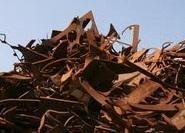Market

March 27, 2018
Scrap Prices Expected to Jump in April
Written by Tim Triplett
Ferrous scrap prices are expected to rise $20 to $30 per gross ton in April, and possibly more, according to Steel Market Update sources. All grades are expected to see increases, and with relative parity across the country.
One dealer told SMU there is pressure on obsolete grades as the long winter has impeded the normal scrap flows. The gap between busheling and obsolete grades has narrowed. Based on iron yield versus price paid, busheling is a better deal and should see upward pressure. Mills in the South still need to draw busheling from the North, he noted.
Turkish mills have laid low due to the uncertainty over Section 232 but will need to buy scrap soon. Export prices have held their own or risen as buyers in other countries such as India and Latin American have filled the void. “Consequently, domestic mills will have to compete with prices at the docks for HMS and frag, and there’s not much to choose from. One U.S. mill reportedly has imported a full shredded cargo from Europe. With the spread between HRC and scrap, this may be a trend worth watching,” the dealer said.
Pig iron prices have increased as the Ukrainians have sold to the U.S. at $415 per metric ton CFR on the heels of a Russian cargo at $410. They expect another round of increases before leveling off. The Brazilian producers won’t have a cargo to sell until May/June shipment and they will definitely ask for higher numbers, he added.
Despite the effects of Section 232 and seasonal issues, the market factors are generally positive and supportive of scrap prices, agreed another dealer in the Northeast. “Inflows to our yards have been relatively muted. Some of that has to do with the poor weather in the East, but some also has to do with expectations of a stronger market come next month causing smaller dealers to hold back a little scrap,” he said.
The biggest driver in April, though, will be solid domestic scrap demand, he said. Export demand has been affected by Turkey, which is in a holding pattern trying to figure out the impact of Section 232 on exports of their finished products. Also, the Turkish currency continues to get crushed against the U.S. dollar.
The other major issue is the wide spread between scrap and coil, which can top $450. “I expect it will remain relatively wide for the foreseeable future until something happens to change the dynamic of the domestic mills’ leverage over the scrap dealers and OEMs/service centers,” said the dealer. “U.S. dealers may cite Section 232 as a reason for the mills to pay more for scrap, but the scrap industry remains too fragmented to really hold out for increases like we have seen over recent weeks on the coil side.”
Scrap guru Mike Marley of World Steel Exchange Marketing said dealers are talking the market up, but he questions whether prices will move as high as some expect. Many see the prime industrial grades jumping by $30 or $40 per ton and the obsolete grades by $10 per ton in April.
Marley points to several issues coloring this outlook. First, this month’s $20, $30 or $35 per ton increases in shredded and cut grades have narrowed the spread between prime and secondary grades. On the surface, it still appears there are spreads of $20 or $25 per ton, but that does not factor in the metal recovery rates for the various grades. Some mills estimate they can recover as much as 98 percent of the steel from grades like bundles and busheling, but only 90-92 percent from shredded. Thus, when the price spread falls to less than $20 per ton and these prices are in the $360 to $400 per ton range, bundles and busheling are the better buy. Consider the math on the cost per ton using AMM’s expanded Chicago footprint prices as examples, Marley said:
$360 (shredded)/0.92 = $391
$375 (busheling-bundles)/0.98 = $383
“It now makes more sense for the integrated mills, as well as the EAF steelmakers producing sheet and SBQ products, to use more prime scrap instead of shredded. Whether they will do that is a separate question,” he said.
Second, some dealers in the Midwest who sold their bundles and busheling early took “sideways” prices for that scrap. A few days later, those who resisted the early sideways offers got higher prices, in some regions increases of $10 to $15 per ton. This month’s early sellers believe scrap demand is still as strong or perhaps even stronger, so they are looking to recoup their losses, Marley said.
Third, despite the zigs and zags in the raw steel production figures (they are down this week), most still see domestic steel demand on the rise and consequently believe the mills will need as much or more scrap in April than they were able to get this month.
Fourth, Marley continued, some dealers have stopped overselling as they did not get as much scrap or shredder feed as they expected in January and February. Ongoing transport problems with rail, truck and barge, on top of the short supply, left many of them still owing scrap to mills at month’s end.
On the price downside, several mills and brokers are already flooding dealers with price-to-be-determined offers. TBDs, if accepted by dealers, help the mills to line up supply in advance. So, a few could start the week knowing they only need, say, 10,000 tons of scrap instead of 100,000 tons, which they may easily obtain from a few smaller dealers at sideways prices or with only a modest increase.
Also, it’s spring and the weather is warmer. That could mean a deluge of obsolete scrap hitting dealers’ yards this month and making them anxious to sell as much as possible as quickly as possible, Marley said.
The two biggest scrap users, namely Nucor and SDI, have been tapping their own home-grown supplies—captive scrap yards and industrial contracts with stampers and other manufacturers. Their captive yards are not selling much to other mills and instead are shipping it to their corporate cousins, which will affect demand in April.
“I don’t think scrap dealers need the Section 232 tariffs to encourage them to seek higher prices. Overall, scrap demand, especially stronger demand for busheling and bundles, will do that,” Marley said.
The post Scrap Prices Expected to Jump in April appeared first on Steel Market Update.






